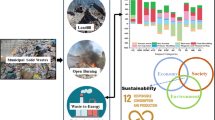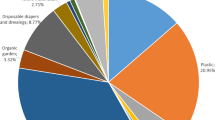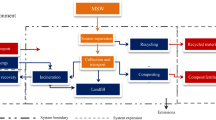Abstract
Purpose
The critical issue of waste management in Thailand has been rapidly increasing in almost all of the cities due to the economic growth and rising population that could double the amount of solid waste in landfill area. The alternative ways of waste treatment that have more efficiency and effectiveness in terms of energy, ecology, and resources become the key issue for each municipality to replace the old fashioned technology and be able to enhance the ability of solid waste problem management. Waste to energy is one of the favorable approaches to diminish the amount of waste to landfill and utilize waste for electricity. The aim of this study is to identify and quantify the life cycle impacts of the municipal solid waste (MSW) of Mae Hong Son municipality (MHSM), and the case study is the selected waste treatment technology of the Refuse-Derived Fuel (RDF) hybrid with 20 kW of Organic Rankine Cycle (ORC).
Methods
The functional unit is defined as 1 t of MSW. The energy, environment, and resource impacts were evaluated by using Life Cycle Assessment (LCA); ReCipe and Net Energy Consumption were referred to calculate the environmental impacts and the benefits of energy recovery of WtE technology. Exergetic LCA was used to analyze the resource consumption, especially land use change.
Results and discussion
The results indicated that the environmental impacts were comparatively high at the operation stage of RDF combustion. On the other hand, the production stage of RDF illustrated the highest energy consumption. The ORC power generation mainly consumed resources from material and energy used. The ORC system demonstrated better results in terms of energy and resource consumption when applied to waste management, especially the land required for landfill. Substitution of electricity production from ORC system was the contributor to the reduction of both energy and resource consumption. Installation of spray dry and fabric filter unit to RDF burner can reduce heavy metals and some pollutants leading to the reduction of most of the impacts such as climate change, human toxicity, and fossil depletion which are much lower than the conventional landfill.
Conclusions
LCA results revealed that the environmental impacts and energy consumption can be reduced by applying the RDF and ORC systems. The exergetic LCA is one of the appropriate tools used to evaluate the resource consumption of MSW. It is obviously proven that landfill contributed to higher impacts than WtE for waste management.





Similar content being viewed by others
Abbreviations
- H :
-
Heat generation (MJ/h)
- LHV :
-
Lower heating value (MJ/kg)
- Eff :
-
Efficiency
- E :
-
Electricity generation (kWh)
- P :
-
Gross power output (kW)
- T :
-
Operation time (hour/year)
- EC :
-
Energy consumption (MJ)
- CED :
-
Cumulative energy demand of material (MJ/unit)
- NEC :
-
Net primary energy consumption (MJ)
- ER :
-
Primary energy reduction (MJ)
- ReC :
-
Resource consumption (MJ)
- CExD :
-
Cumulative exergy demand of material (MJ/unit)
- L :
-
Land
- NReC :
-
Net resource consumption (MJ)
- ReR :
-
Resource reduction (MJ)
- CF :
-
Characterization factor
- HWG :
-
Hot water generator
- Tot :
-
Total
- Con :
-
Consumption
- ORC :
-
Organic Rankine Cycle
- Occ :
-
Occupation
References
Alvarenga RF, Dewulf J, Langenhove H, Huijbregts MJ (2013) Exergy-based accounting for land as a natural resource in life cycle assessment. Int J Life Cycle Assess 18:939–947
Bai L (2012) Life cycle assessment of electricity generation from low temperature waste heat. Norwegian University of Science and Technology, Dissertation
Chaiyat N (2015) Sustainability of alternative energy for organic rankine cycle power plant in Thailand. Naresuan University Journal: Science and Technology 23:45–62
CMU (2014) Demonstration project on RDF-5 production from municipal waste: a case study of Chiang Mai University. Chiang Mai University, Chiang Mai, Thailand
Cornelissen RL, Hirs GG (2002) The value of the exergetic life cycle assessment besides the LCA. Energ Convers Manage 43:1417–1424
DEDE (2015) Energy situation of Thailand January – September 2015, Department of Alternative Energy Development and Efficiency, Ministry of Energy. Thailand: http://www.dede.go.th/download/state_58/sit_57_58/frontpage_sep58%20(1).pdf. Accessed 31 January 2016
Dewulf J, Bösch ME, Meester BD, Vorst GV, Langenhove HV, Hellweg S, Huijbregts MAJ (2007) Cumulative exergy extraction from the natural environment (CEENE): a comprehensive life cycle impact assessment method for resource accounting. Environ Sci Technol 41:8477–8483
Department of Tourism, Ministry of Tourism and Sports (2016) http://marketingdatabase.tat.or.th/ewt_w3c/ewt_news.php?nid=1621. Accessed 31 January 2016
Ecoinvent (2007) Ecoinvent V 3.0 Database. Swiss Centre for Life Cycle Inventories, Dübendorf, Switzerland
EEA (2013) EMEP/EEA air pollutant emission inventory guidebook 2013: technical guidance to prepare national emission inventories, European Environment Agency, publications Office of the European. Union, Luxembourg
EPA (1995) Complication of air pollutant emission factors Vol. 1: Stationary point and area sources, Office of Air Quality Planning and Standards & Office of Air and Radiation, US Environment Protection Agency
Frischknecht R, Jungbluth N, Althaus HJ, Bauer C, Doka G, Dones R, Hischier R, Hellweg S, Humbert S, Köllner T, Loerincik Y, Margni M, Nemecek T (2007) Implementation of life cycle impact assessment methods, Ecoinvent report no. 3. Swiss Centre for Life Cycle Inventories, Duebendorf
Goedkoop M, Heijungs R, Huijbregts M, Schryver AD, Struijs J, Van Zelm R (2009) ReCiPe 2008: a life cycle impact assessment method which comprises harmonised category indicators at the midpoint and the endpoint level, first edition. Report I: characterisation
Huysveld S, De Meester S, Van linden V, Muylle H, Peiren N, Lauwers L, Dewulf J (2015) Cumulative overall resource efficiency assessment (COREA) for comparing bio-based products with their fossil-derived counterparts. Resour Conserv Recy 102:113–127
IPCC (2006) 2006 IPCC Guidelines for National Greenhouse Gas Inventories, Prepared by the National Greenhouse Gas Inventories Programme, Eggleston HS, Buendia L, Miwa K, Ngara T, Tanabe K (eds). Published: IGES, Japan
Johnson J, Reck BK, Wang T, Graedel TE (2008) The energy benefit of stainless steel recycling. Energ Policy 36:181–192
Liu C, He C, Gao H, Xie H, Li Y, Wu S, Xu J (2013) The environmental impact of organic rankine cycle for waste heat recovery through life-cycle assessment. Energy 56:144–154
Perilhon C, Alkadee D, Descombes G, Lacour S (2012) Life Cycle Assessment Applied to Electricity Generation from Renewable Biomass. Terragreen 2012: Clean Energy Solutions for Sustainable Environment (CESSE) 18:165–176
Taelman SE, De Meester S, Schaubroeck T, Sakshaug E, Alvarenga RAF, Dewulf J (2014) Accounting for the occupation of the marine environment as a natural resource in life cycle assessment: an exergy based approach. Resour Conserv Recy 91:1–10
Uusitalo A, Uusitalo V, Gronman A, Luoranen M, Jaatinen-Varri A (2016) Greenhouse gas reduction potential by producing electricity from biogas engine waste heat using organic rankine cycle. J Clean Prod 127:399–405
Walsh C, Thornley P (2012) The environmental impact and economic feasibility of introducing an organic rankine cycle to recover low grade heat during the production of metallurgical coke. Recent Cleaner Production Advances in Process Monitoring and Optimisation 34:29–37
Wang H, Xu J, Yang X, Miao Z, Yu C (2015) Organic rankine cycle saves energy and reduces gas emissions for cement production. Energy 86:59–73
Acknowledgments
This work has been supported by Thai Government Science and Technology Scholarship, National Science and Technology Development Agency (NSTDA); The Graduate School, Chiang Mai University; Energy Policy and Planning Office, Ministry of Energy, and Chiang Mai University.
Author information
Authors and Affiliations
Corresponding author
Additional information
Responsible editor: Thapat Silalertruksa
Rights and permissions
About this article
Cite this article
Sedpho, S., Sampattagul, S., Chaiyat, N. et al. Conventional and exergetic life cycle assessment of organic rankine cycle implementation to municipal waste management: the case study of Mae Hong Son (Thailand). Int J Life Cycle Assess 22, 1773–1784 (2017). https://doi.org/10.1007/s11367-016-1216-4
Received:
Accepted:
Published:
Issue Date:
DOI: https://doi.org/10.1007/s11367-016-1216-4




